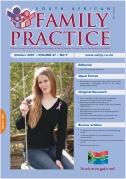Antenatal prevention of mother to child transmission of HIV
Abstract
An effective perinatal mother to child transmission (PMTCT) programme will reduce perinatal acquired HIV infections. This goal is within reach of the South African public health sector. Early antenatal attendance and knowledge of HIV status allows sufficient time to implement highly active antiretroviral therapy (HAART) or ART intervention. Both measures have been proved to be efficient to reduce MTCT of HIV. A transmission rate of 2% can be achieved with a dual therapy regimen in non-breastfeedingwomen. Mono therapy with single dose nevirapine (sd NVP) often fails due to the once off nature of the intervention as opposed to ample opportunity to administer zudovudine (AZT) antenatally with dual therapy. A higher CD4 threshold to initiate HAART increases the window of opportunity while women are reasonably healthy. Irrespective of the maternal disease the newborn babies receive the same ART regimen. Women requiring HAART following pregnancy with an interval of 6 months or longer since NVP exposure had the same virological response as compared to NVP naïve women. Dual or mono therapy for a second time will be as effective as with NVP naïve women. The present day routine use of ART will reduce the risk of obstetric interventions.
Section
Review Articles
By submitting manuscripts to SAFP, authors of original articles are assigning copyright to the South African Academy of Family Physicians. Copyright of review articles are assigned to the Publisher, Medpharm Publications (Pty) Ltd, unless otherwise specified. Authors may use their own work after publication without written permission, provided they acknowledge the original source. Individuals and academic institutions may freely copy and distribute articles published in SAFP for educational and research purposes without obtaining permission.

